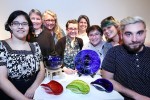From left to right are artists Larissa Blokhuis, Kirsten Rankel, Maria Keating, Sonya Labrie, Joanne Andrighetti, Hope Forstenzer, Mona Ungar and Scott McDougall. (photo by Denise Relke)
From antiquity, glass has been used for utilitarian and ornamental purposes. The current group show at Zack Gallery, Works in Glass from Terminal City Glass Co-op, demonstrates both functions in the elegant and colorful creations of co-op members. Vases and funky animal sculptures, jewelry and abstract decorative pieces transform the gallery into a celebration of light and flowing forms.
Holly Mira Cruise, one of the co-op founders and its current executive director, told the Independent a little about the group’s history.
“Terminal City Glass Co-op is the first and only nonprofit, cooperative glass arts facility in Canada. It was founded in February of 2012 by Morley Faber, Joanne Andrighetti, Jeff Holmwood and myself. We came together around a mutual desire to see the glass community in Vancouver grow…. We have worked together since then. We started with 30 members, and we now have over 150. It’s a constantly changing community, and we see new members come in every month, and others move on to other opportunities.”
Many co-op members exhibit their glass art often, attracting interest from both customers and professionals. That’s how Linda Lando, director of the Zack, discovered them.
“Linda reached out to me earlier this year,” said Hope Forstenzer, one of the show participants and a member of the local Jewish community. “She had seen some of our co-op’s pieces during Culture Crawl, liked them, and wanted to talk about a show at the Zack.”
Forstenzer herself is in love with glass. “Glass is an amazing medium. It’s elemental,” she said. “There is nothing like it in the whole world. At different stages, it could be liquid and malleable or hard and bullet resistant. It reflects light and allows colors to play inside. It’s created with fire.”
A professional artist, Forstenzer didn’t start her artistic life with glass. “I worked in ceramics and, at one point, I designed several pieces as a combination of glass and ceramics. I couldn’t find the glass I wanted so I started taking classes to make my own glass. I loved it so much, I stopped doing ceramics and concentrated on glass.”
She even moved from New York to Seattle because of her fascination. “Many of the best glass artists in the world live and work in Seattle, and I studied with some of them. There are two glass centres in the world. Venice is one. Seattle is another.”
When her partner took a job in Vancouver a few years ago, Forstenzer moved here. She has been teaching glass-making for about 10 years now. She teaches a class at the co-op, and she also teaches graphic design at Emily Carr University of Art + Design.
Like Forstenzer, Cruise is also passionate about glass. “I tried almost every medium before glass. I painted and drew, I tried clay and metals, I made jewelry. I was an art school dropout. A friend who had been blowing glass since he was a kid told me, ‘Try glass, you’ll like it!’ He was right. I liked it and I never looked back. I became really attracted to the material, to the way it moves and feels and, of course, all the amazing colors. Glass is enthralling in a way that no other material has been for me. I think a lot of people find it has addictive qualities. There have been times over the past 20 years when I have taken a break from glass, but I always seem to go back. It calls me.”
To answer that call, she not only works as a glass artist but also manages the co-op, organizing all its programs and classes, and bringing in visiting instructors from all over the world. “TCGC offers classes in glassblowing, beadmaking, flameworking and sandblasting,” she said. “We make it easy for people to take the first steps. We also offer advanced learning opportunities for people who have practised for awhile. There is no post-secondary glass program in Vancouver, but there is one at Alberta College of Art and Design and at Sheridan College in Ontario. Hopefully, we will catch up with other provinces soon.”
Widely available education in glass-making is a relatively new development for such an ancient craft. Before the 20th century, glass was mostly worked at factories, and each one guarded its secrets.
“In the 1960s, the Studio Glass Movement started,” Cruise explained. “Glass-making moved from factories to independent artist studios. It became a lot easier for people to approach glass and learn it…. Today, there are books on how to set up your own studio and build your own equipment. People are 3-D printing with glass. This year, Emily Carr ran its first class in 3-D Design with Glass through our studio. It was a great success, and seeing the potential of glass as a material to be enhanced and developed with technology was thrilling.”
According to both Cruise and Forstenzer, the students taking classes at the co-op come in all ages and artistic levels.
“Our students are pretty diverse,” said Cruise. “We get all ages, from 17 to 75. Sometimes, it’s retired people who want to pick up a hobby, or younger people who want to become glass artists, or couples looking for something fun to do. We have something for everyone to try here.”
Works in Glass runs until Jan. 10. For more information about the co-op, visit terminalcityglass.com.
Olga Livshin is a Vancouver freelance writer. She can be reached at [email protected].

